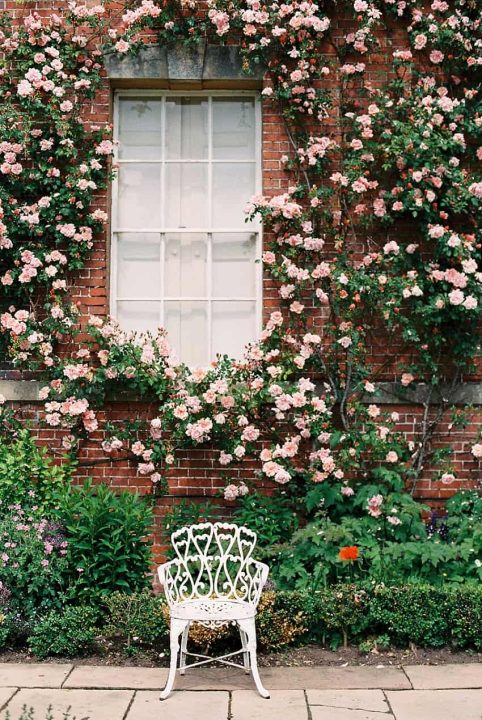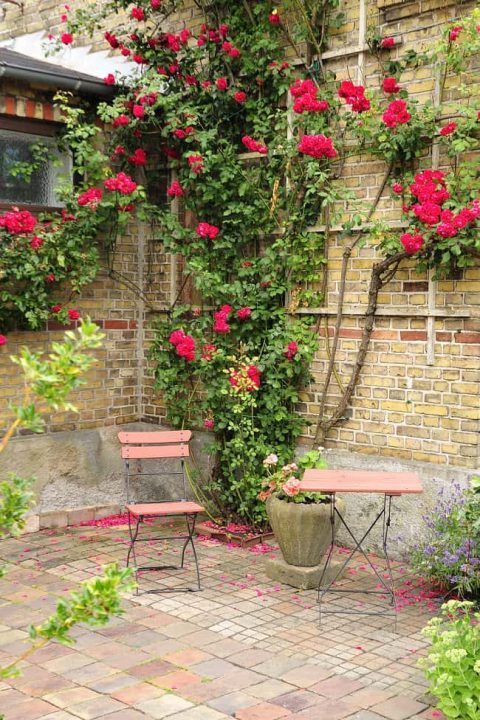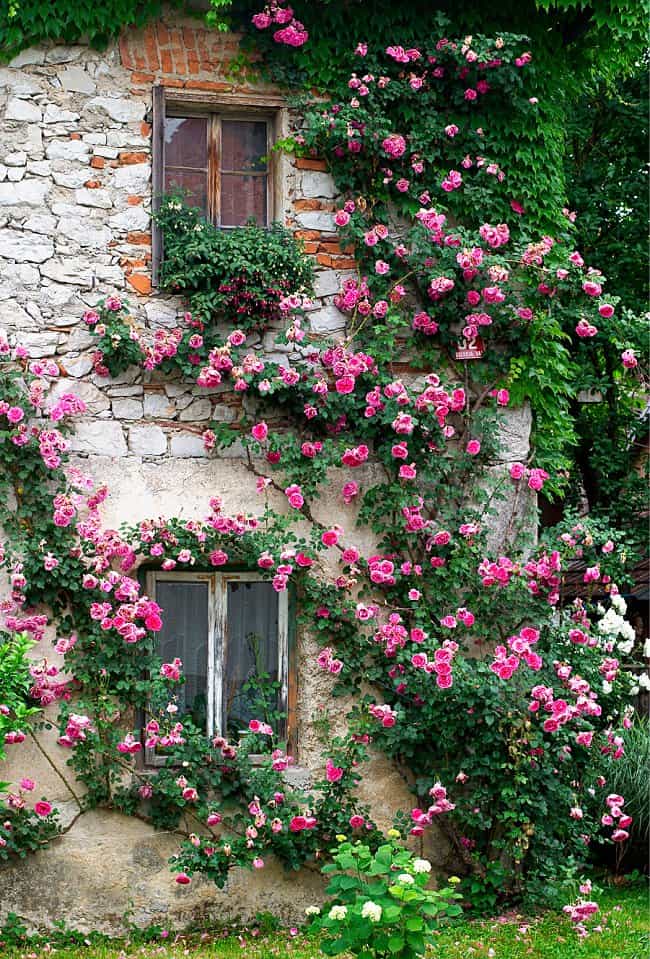I confess, I am an absolute sucker for those dreamy cottages you see on Pinterest – all old brickwork and covered in rambling roses. I mean, how could you not want a little corner like this in your dream home!?

Disclosure: as an Amazon Associate we earn from qualifying purchases. Learn more.
However there might be a slight problem in achieving that dreamy look – vines are notorious for damaging brickwork and mortar. Ivy has been known to make entire walls and homes crumble, over time! Not so dreamy.
But what about rose vines, can they damage or destroy brick? The good news is that climbing roses are nowhere near as invasive as plants like ivy. In fact, climbing roses can grow happily up your brick walls for decades, if given the right care and treatment, without any brickwork damage at all. In order to prevent climbing roses damaging your brickwork, use a trellis to establish growth, prune carefully and be sure to choose a species that is less invasive. Plastic brick clips with wire support are the safest way to attach climbing roses to brick.
These tips will help you to create a climbing rose wall that not only wows everyone who sees it and scents your home or garden beautifully, it will help protect your brick and mortar too!
Table of Contents
Will Vines Damage A Brick Wall?
Guess what – climbing roses don’t actually climb! They’re more like big, leggy roses that love to grow around whatever they happen to be close to – whether that’s an arch, a trellis, brick clips, or even trees. Because they aren’t true ‘climbers’ they don’t produce little suckers common of more invasive plant species – so they are very, very unlikely to damage any of your brickwork!
Although you can grow climbing roses up a brick wall safely, without fear of it damaging your brick, for the best results, your rose is going to need some support. Climbing roses actually don’t ‘climb’ by themselves – they need support for all those big, heavy beautiful blooms. So they need something to effectively grow around, or be held up by. For that you might need a trellis, brick clips, an arch or even some other kind of plant for it to grow around or cling to – all of which could involve drilling holes in your brickwork!
So, while climbing roses are not bad for your brickwork, you will want to choose your support carefully.
How To Support Climbing Roses On A Brick Wall
Growing gorgeous climbing roses on a brick wall almost always involves some kind of support. Believe it or not, those beautiful canes that curl so prettily around old stately homes and cottages don’t actually grow that way. Behind those blooms usually lies a support structure – usually a trellis, ground hooks, or clips.
Which support structure you choose depends on the height and width of your rose, and the shape you desire for your climbing rose.
Provide Structural Support
There are three main types of support for climbing roses on brick. Support structures are used to give your rose stems something to ‘wrap’ around. If your climbing rose is already in flower, support structures help to support the weight of the blooms too. There are four main types of climbing rose support.
- brick clips
- brick clips with a wire support
- trellis
- standing canes
Brick Clips
Brick clips used to be, essentially, nails that you drill into your wall. They are still used on many stately homes, or when you need an extremely durable solution that may last for decades! So if you have a particularly old or large grand house, then metal brick clips are the way to go.
You can pick them up from local garden centres and you simply drill small holes (what size will depend on your brick clip size) and twist in your clips. Clip your cane to your brick clips, and voila! Done.
Brick clips are slightly invasive to your wall, as you will need to drill slight holes. However they aren’t known to cause any long term damage. The only problem with brick clips is that the holes will need filling if you ever decide to remove your climbing rose from your wall. However, you’re probably thinking of growing climbing roses for the long term, so that’s not usually a huge issue. Also, the holes are usually shallow, and aren’t particularly noticeable.
Trellis Kit – The Safest Way To Attach Rose Vines To Brick
You can now purchase a wall trellis kit, which is available on Amazon. These not only anchors that do not require drilling, but they contain wire which forms an ‘invisible trellis’ for the roses to climb. This wall trellis kit is the safest option to prevent climbing rose damage to your brickwork, as they do not require drilling into place.
These are super strong, last through storms, (even British ones)! and are much more flexible than say, a trellis. They also offer your climbing rose more support than just the standard metal brick clips, or the brick clips on their own. Your rose cane has both the clip itself to hold it up and the wire to wrap itself around!
The flexibility given by the wire means your roses have space to wrap themselves around. This means you get to shape your climbing rose whatever way you like – great for rose arches, above doorways or around windows. (Trust us, this Amazon kit is amazing for climbing roses – you can literally decorate your entire house with climbing roses with the ease of this kit)!
And if for whatever reason your climbing rose fails, or your clips come out of place, or they fall from the wire, it’s a simple fix. Unless the entire cane has been destroyed (unlikely), you simply pin back or rewrap the stem around another piece of wire or clip. You just reclip it all back up again! This is harder to do with traditional metal clips which might rust and snap – it requires more drilling of holes!
So, plastic and wire climbing rose clips are more user-friendly and less labour intensive. We very rarely recommend the use of plastics, but this is one of those times where it’s kind of an essential, and there isn’t much of it anyway.
Trellis
A trellis has long been a favoured way to support climbing roses, and as they are made of wood and have a pleasing pattern, can often be part of the rose aesthetic and look pretty in their own right.
For a wooden trellis, you usually have to drill holes into your brickwork to support them. For specific instructions, check out this post here.
Standing Canes
Metal and bamboo garden canes can be used while your climbing rose is still in its infancy, to support the growth of the intial main cane.
Place them around 3inches into the soil, around the same width (3 inches) away from your plant, to protect the roots. This gives your roses an initial stable base to begin climbing. Once your climbing rose has reached the top of the main cane, it will be strong enough to begin to sprawl across your walls, with the help of any of the above supports.
What Varieties Of Climbing Rose Are Best For Brick?
If you want to grow a climbing rose up the side of your house or around a feature (such as a window or door, or to disguise brickwork), you’re going to want a vigorous climber, unless you want to wait for years on end for that beautiful look to be achieved! Some of the most popular varieties for brick are
- David Austin’s Iceberg (white roses, produces many blooms)
- David Austin’s New Dawn – hugely popular, medium sized pink blossoms
- Polka / Polkar – soft peach flowers, large blooms, strong fragrance
- Kiss Me Kate – pink, heavy fragrance, make great cut flowers to bring indoors as well as a great climber
So, you now know that climbing roses can be grown around brick very safely! Climbing roses definitely aren’t bad for brick, and if you choose the right support, you’ll have the frontage of your house blooming in no time.
Tell us about your climbing roses, below, they’re some of our absolute favourites! Or leave us a question.
If you’re growing climbing roses, don’t miss this post here. It will keep that climbing rose growing and looking beautiful for years to come!





